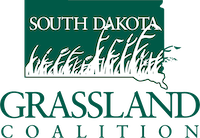By Garnet Perman
Layering enterprises is one way to maximize all the resources of a given operation to benefit both economic and ecological bottom lines. After attending a Ranching for Profit school in 2016, Dugan Bad Warrior of Dupree started looking for different ways to take advantage of his grass resource. He started asking himself, “How can I do that?” instead of telling himself “I can’t do that.”
Grouping cattle by age and/or purpose has helped him economically while also protecting the resource. Currently Herd A is young cows 3-6 years of age. Herd B has cows age 7- broken mouth and Herd C is replacement heifers. In the past he has utilized custom grazed herds and older herds, 7-9 years old and 10+.
In an area of the state where drought is common, having a drought plan and following through on it makes a big difference. His plan for reducing the number of cattle in a dry year includes determining which group of cattle leaves when trigger dates are met. The first to go are custom grazed cattle—the contract includes this scenario. The second group of cattle is the replacement heifers with the thought that it is better to keep cows that have raised calves instead of young unproven cows. Third to go is the oldest cows and a very last resort would be to sell or find other pasture for the young cows. Last year’s drought necessitated some destocking. Bad Warrior said implementing the drought plan dinged his pocketbook short-term but he has more options this year because his grass is healthy. For example, he can do some custom grazing rather than restock at high prices.
Bad Warrior tries to spend Monday mornings in the office going over grazing plans and finances, paying attention to how gross margins mesh with his cost of operation. “Make sure the ranch works economically or it will never cash flow”, he said. He’ll run all his numbers every quarter or sooner if a big change in markets or some sort of black swan event occurs. One of his goals is to diversify as much as possible. Enterprises he’s considered include buying short-term bred cows and multispecies grazing with sheep.
Running yearlings have been part of Dan Rasmussen’s enterprise structure for years. Whether the pasture contains your own yearlings, custom grazing or running yearlings for a contract, Rasmussen’s first recommendation is do a resource inventory to determine whether or not there is enough grass for this enterprise to make sense in the first place. The Natural Resource Conservation Service has tables for different parts of the state to help determine how much forage to leave standing to keep the soil covered and be resilient and productive. In western SD, that number may average 1,250lbs/acre. Once the herd has taken the forage down to that amount, they need to move.
Some of the pluses of grazing yearlings include a ready market all summer long, and ease of stocking or destocking depending on range conditions. Yearlings move easily (Rasmussen moves his with a drone) and can be contained with one strand of high tensile wire or trained to electric polywire. They adapt well to intensive grazing plans, enhancing soil health.
Some of the downsides include the need for a detailed contract if custom grazing. An article and some sample contracts can be found at https://extension.sdstate.edu/sites/default/files/2020-06/P-00174.pdf. A mineral consultant that can prescribe a mix that fits your ranch and a good working relationship with a vet are part of being prepared to deal with health problems that can pop up.
The flexibility yearlings provide make them an attractive option for many operations. Decisions regarding yearlings need to be based on goals and financial considerations. For example, current prices make keeping newly weaned calves pricey because keeping them is like buying them at market price.
The Grazing School addresses many of the issues that come with adding diversity to the ranch and also offers a follow up program with a consultant that focuses on healthy soils.
Garnet Perman is a freelance writer and ranches with her husband, Lyle, near Lowry, SD.
